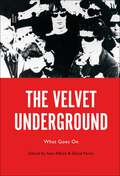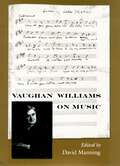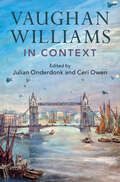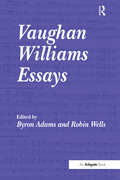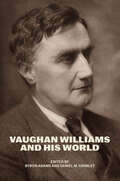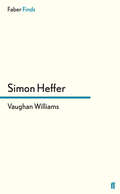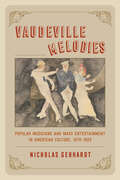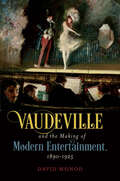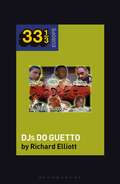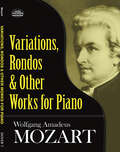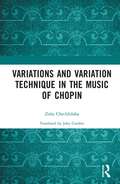- Table View
- List View
The Velvet Underground: What Goes On
Though The Velvet Underground were critically and commercially unsuccessful in their time, in ensuing decades they have become a constant touchstone in art rock, punk, post-punk, indie, avant pop and alternative rock. In the 1970s and 80s Lou Reed, John Cale and Nico produced a number of works that traveled a path between art and pop. In 1993 the original band members of Reed, Cale, Morrison and Tucker briefly reunited for live appearances, and afterwards Reed, Cale and briefly Tucker, continued to produce music that travelled the idiosyncratic path begun in New York in the mid-1960s.The influence of the band and band members, mediated and promoted through famous fans such as David Bowie and Brian Eno, seems only to have expanded since the late 1960s. In 1996 the Velvet Underground were in inducted into the Rock and Roll Hall of Fame, demonstrating how far the band had traveled in 30 years from an avant-garde cult to the mainstream recognition of their key contributions to popular music. In these collected essays, Pattie and Albiez present the first academic book-length collection on The Velvet Underground. The book covers a range of topics including the band's relationship to US literature, to youth and cultural movements of the 1960s and beyond and to European culture - and examines these contexts from the 1960s through to the present day.
Vaughan Williams on Music
by David ManningThis book makes a substantial collection of Vaughan Williams's writings widely available to music lovers, students, and researchers alike. It comprises 102 items written by the composer between 1897 and the year of his death, 1958, including articles for musical magazines, transcripts of broadcasts, obituary notices and program notes. The great majority of items in this anthology have been unavailable since their initial publication, some have never been published, and very few have been reprinted. Vaughan Williams reveals the many roles he played during his life in the pages of this book: he was an active supporter of amateur music-makers, a leader in the folksong revival, educator, performer, campaigner for English music, and polemicist. Through all these perspectives, the words are unmistakably those of a composer who came to believe it his duty to build an active and cohesive musical community within his native country.
Vaughan Williams in Context (Composers in Context)
by Julian Onderdonk Ceri OwenChallenging residual doubts about Vaughan Williams's role and significance within twentieth-century music and culture, this book places and explores his life and music in their broad musical, cultural, social, and political contexts. Chapters by scholars from a range of disciplines re-evaluate the composer's life and career within a world marked by both rapid change and refigured traditions. Building on scholarship that has established Vaughan Williams as aesthetically and politically progressive, the book furthers a revisionist perspective by broadening understandings of the nature of his responses to the twentieth century. This portrait of a modern composer emerges not merely by focusing on under-represented interests and pursuits, but also by contextualizing those activities that have been misrepresented as conservative or backward-looking.
Vaughan Williams Essays
by Byron Adams Robin WellsSerious scholarship on the music of Ralph Vaughan Williams is currently enjoying a lively revival after a period of relative quiescence, and is only beginning to address the enduring affection of concert audiences for his music. The essays that comprise this volume extend the study of Vaughan Williams's music in new directions that will be of interest to scholars, performers and listeners alike. This volume contains the work of eleven North American scholars who have been recipients of the Ralph Vaughan Williams Fellowship based at the composer's own school, Charterhouse, which was created and has been supported by the Carthusian Trust since 1985. This wide-ranging and detailed collection of essays covers the spectrum of genres in which Vaughan Williams wrote, including dance, symphony, opera, song, hymnody and film music. The contributors also employ a range of analytical and historical methods of investigation to illuminate aspects of Vaughan Williams's compositional techniques and influences, musical, literary and visual.
Vaughan Williams Essays
by Robin WellsSerious scholarship on the music of Ralph Vaughan Williams is currently enjoying a lively revival after a period of relative quiescence, and is only beginning to address the enduring affection of concert audiences for his music. The essays that comprise this volume extend the study of Vaughan Williams's music in new directions that will be of interest to scholars, performers and listeners alike. This volume contains the work of eleven North American scholars who have been recipients of the Ralph Vaughan Williams Fellowship based at the composer's own school, Charterhouse, which was created and has been supported by the Carthusian Trust since 1985. This wide-ranging and detailed collection of essays covers the spectrum of genres in which Vaughan Williams wrote, including dance, symphony, opera, song, hymnody and film music. The contributors also employ a range of analytical and historical methods of investigation to illuminate aspects of Vaughan Williams's compositional techniques and influences, musical, literary and visual.
Vaughan Williams and His World (The Bard Music Festival)
by Byron Adams Daniel M. GrimleyA biography of Ralph Vaughan Williams, published in collaboration with the Bard Music Festival. Ralph Vaughan Williams (1872–1958) was one of the most innovative and creative figures in twentieth-century music, whose symphonies stand alongside those of Sibelius, Nielsen, Shostakovich, and Roussel. After his death, shifting priorities in the music world led to a period of critical neglect. What could not have been foreseen is that by the second decade of the twenty-first century, a handful of Vaughan Williams’s scores would attain immense popularity worldwide. Yet the present renown of these pieces has led to misapprehension about the nature of Vaughan Williams’s cultural nationalism and a distorted view of his international cultural and musical significance. Vaughan Williams and His World traces the composer’s stylistic and aesthetic development in a broadly chronological fashion, reappraising Vaughan Williams’s music composed during and after the Second World War and affirming his status as an artist whose leftist political convictions pervaded his life and music. This volume reclaims Vaughan Williams’s deeply held progressive ethical and democratic convictions while celebrating his achievements as a composer.
Vaughan Williams and His World (The Bard Music Festival)
by Byron Adams and Daniel M. GrimleyA biography of Ralph Vaughan Williams, published in collaboration with the Bard Music Festival. Ralph Vaughan Williams (1872–1958) was one of the most innovative and creative figures in twentieth-century music, whose symphonies stand alongside those of Sibelius, Nielsen, Shostakovich, and Roussel. After his death, shifting priorities in the music world led to a period of critical neglect. What could not have been foreseen is that by the second decade of the twenty-first century, a handful of Vaughan Williams’s scores would attain immense popularity worldwide. Yet the present renown of these pieces has led to misapprehension about the nature of Vaughan Williams’s cultural nationalism and a distorted view of his international cultural and musical significance. Vaughan Williams and His World traces the composer’s stylistic and aesthetic development in a broadly chronological fashion, reappraising Vaughan Williams’s music composed during and after the Second World War and affirming his status as an artist whose leftist political convictions pervaded his life and music. This volume reclaims Vaughan Williams’s deeply held progressive ethical and democratic convictions while celebrating his achievements as a composer.
Vaughan Williams
by Simon HefferA tweedy purveyor of folklore; too many larks ascending and too much Linden Lea: no composer's work has ever been more cruelly stereotyped than that of Ralph Vaughan Williams. The truth could hardly have been more different: that folksy feel masked the highest sophistication, that countrified air the most audacious experimentation. If, unlike his Germanizing contemporary Elgar, Vaughan Williams did indeed open the way to a distinctively English Music, his was an Englishness which owed nothing to narrow-mindedness or lack of artistic enterprise. Fifty years after his death in 1958, Vaughan Williams' reputation is greater than ever before and there is a resurgence of interest in his music. Re-issued to coincide with this anniversary, Simon Heffer's perceptive book lends weight to the increasingly compelling case for Vaughan Williams' recognition as the most important English composer of the twentieth century. 'A vivid and appealing picture of an irresistibly likeable figure ... I enjoyed this little book enormously.'Spectator'An affectionate, accurate and shrewd account of Vaughan Williams' life ... the author's astute commentary on it betokens close and knowledgeable acquaintance.' Sunday Telegraph
Vaughan Williams (Master Musicians Series)
by Eric SaylorA new biography of which paints the most well-rounded and factually accurate portrait of the composer to date Ralph Vaughan Williams ranks among the most versatile, influential, and enduringly popular British musicians of his era. Throughout his wide-ranging career-as composer, conductor, editor, scholar, folksong collector, teacher, author, administrator, and philanthropist-Vaughan Williams worked tirelessly to improve the standards and quality of British musical life. His dedicated work ethic and fastidious attention to musical detail helped him forge a compelling and original expressive idiom grounded in a profound understanding of musical history and tradition, popularized in concert staples like the Tallis Fantasia, The Lark Ascending, A London Symphony, the Songs of Travel, and the Serenade to Music. Drawing upon both recent scholarship and newly accessible scores and correspondence, author Eric Saylor interweaves in Vaughan Williams an exploration of the composer's life - including new insights about his early career, military service in the Great War, and relationships with the women he loved and married - with chapters surveying his enormous body of music, spanning hymn tunes to operas, keyboard etudes to solo concerti, wind band music for amateurs to perhaps the finest symphonic cycle of the twentieth century. The resulting portrait reveals Vaughan Williams's complex artistry and dynamic personality, a portrayal often at odds with the avuncular persona of "Uncle Ralph" familiar to the public. This contemporary reassessment of the composer's life and works provides a concise and engaging overview of both, positioning Vaughan Williams as an artist of rare skill, sensitivity, and human insight.
Vaughan Williams (Master Musicians Series)
by Eric SaylorA new biography of which paints the most well-rounded and factually accurate portrait of the composer to date Ralph Vaughan Williams ranks among the most versatile, influential, and enduringly popular British musicians of his era. Throughout his wide-ranging career-as composer, conductor, editor, scholar, folksong collector, teacher, author, administrator, and philanthropist-Vaughan Williams worked tirelessly to improve the standards and quality of British musical life. His dedicated work ethic and fastidious attention to musical detail helped him forge a compelling and original expressive idiom grounded in a profound understanding of musical history and tradition, popularized in concert staples like the Tallis Fantasia, The Lark Ascending, A London Symphony, the Songs of Travel, and the Serenade to Music. Drawing upon both recent scholarship and newly accessible scores and correspondence, author Eric Saylor interweaves in Vaughan Williams an exploration of the composer's life - including new insights about his early career, military service in the Great War, and relationships with the women he loved and married - with chapters surveying his enormous body of music, spanning hymn tunes to operas, keyboard etudes to solo concerti, wind band music for amateurs to perhaps the finest symphonic cycle of the twentieth century. The resulting portrait reveals Vaughan Williams's complex artistry and dynamic personality, a portrayal often at odds with the avuncular persona of "Uncle Ralph" familiar to the public. This contemporary reassessment of the composer's life and works provides a concise and engaging overview of both, positioning Vaughan Williams as an artist of rare skill, sensitivity, and human insight.
Vaudeville Melodies: Popular Musicians and Mass Entertainment in American Culture, 1870-1929
by Nicholas GebhardtIf you enjoy popular music and culture today, you have vaudeville to thank. From the 1870s until the 1920s, vaudeville was the dominant context for popular entertainment in the United States, laying the groundwork for the music industry we know today. In Vaudeville Melodies, Nicholas Gebhardt introduces us to the performers, managers, and audiences who turned disjointed variety show acts into a phenomenally successful business. First introduced in the late nineteenth century, by 1915 vaudeville was being performed across the globe, incorporating thousands of performers from every branch of show business. Its astronomical success relied on a huge network of theatres, each part of a circuit and administered from centralized booking offices. Gebhardt shows us how vaudeville transformed relationships among performers, managers, and audiences, and argues that these changes affected popular music culture in ways we are still seeing today. Drawing on firsthand accounts, Gebhardt explores the practices by which vaudeville performers came to understand what it meant to entertain an audience, the conditions in which they worked, the institutions they relied upon, and the values they imagined were essential to their success.
Vaudeville Melodies: Popular Musicians and Mass Entertainment in American Culture, 1870-1929
by Nicholas GebhardtIf you enjoy popular music and culture today, you have vaudeville to thank. From the 1870s until the 1920s, vaudeville was the dominant context for popular entertainment in the United States, laying the groundwork for the music industry we know today. In Vaudeville Melodies, Nicholas Gebhardt introduces us to the performers, managers, and audiences who turned disjointed variety show acts into a phenomenally successful business. First introduced in the late nineteenth century, by 1915 vaudeville was being performed across the globe, incorporating thousands of performers from every branch of show business. Its astronomical success relied on a huge network of theatres, each part of a circuit and administered from centralized booking offices. Gebhardt shows us how vaudeville transformed relationships among performers, managers, and audiences, and argues that these changes affected popular music culture in ways we are still seeing today. Drawing on firsthand accounts, Gebhardt explores the practices by which vaudeville performers came to understand what it meant to entertain an audience, the conditions in which they worked, the institutions they relied upon, and the values they imagined were essential to their success.
Vaudeville Melodies: Popular Musicians and Mass Entertainment in American Culture, 1870-1929
by Nicholas GebhardtIf you enjoy popular music and culture today, you have vaudeville to thank. From the 1870s until the 1920s, vaudeville was the dominant context for popular entertainment in the United States, laying the groundwork for the music industry we know today. In Vaudeville Melodies, Nicholas Gebhardt introduces us to the performers, managers, and audiences who turned disjointed variety show acts into a phenomenally successful business. First introduced in the late nineteenth century, by 1915 vaudeville was being performed across the globe, incorporating thousands of performers from every branch of show business. Its astronomical success relied on a huge network of theatres, each part of a circuit and administered from centralized booking offices. Gebhardt shows us how vaudeville transformed relationships among performers, managers, and audiences, and argues that these changes affected popular music culture in ways we are still seeing today. Drawing on firsthand accounts, Gebhardt explores the practices by which vaudeville performers came to understand what it meant to entertain an audience, the conditions in which they worked, the institutions they relied upon, and the values they imagined were essential to their success.
Vaudeville Melodies: Popular Musicians and Mass Entertainment in American Culture, 1870-1929
by Nicholas GebhardtIf you enjoy popular music and culture today, you have vaudeville to thank. From the 1870s until the 1920s, vaudeville was the dominant context for popular entertainment in the United States, laying the groundwork for the music industry we know today. In Vaudeville Melodies, Nicholas Gebhardt introduces us to the performers, managers, and audiences who turned disjointed variety show acts into a phenomenally successful business. First introduced in the late nineteenth century, by 1915 vaudeville was being performed across the globe, incorporating thousands of performers from every branch of show business. Its astronomical success relied on a huge network of theatres, each part of a circuit and administered from centralized booking offices. Gebhardt shows us how vaudeville transformed relationships among performers, managers, and audiences, and argues that these changes affected popular music culture in ways we are still seeing today. Drawing on firsthand accounts, Gebhardt explores the practices by which vaudeville performers came to understand what it meant to entertain an audience, the conditions in which they worked, the institutions they relied upon, and the values they imagined were essential to their success.
Vaudeville Melodies: Popular Musicians and Mass Entertainment in American Culture, 1870-1929
by Nicholas GebhardtIf you enjoy popular music and culture today, you have vaudeville to thank. From the 1870s until the 1920s, vaudeville was the dominant context for popular entertainment in the United States, laying the groundwork for the music industry we know today. In Vaudeville Melodies, Nicholas Gebhardt introduces us to the performers, managers, and audiences who turned disjointed variety show acts into a phenomenally successful business. First introduced in the late nineteenth century, by 1915 vaudeville was being performed across the globe, incorporating thousands of performers from every branch of show business. Its astronomical success relied on a huge network of theatres, each part of a circuit and administered from centralized booking offices. Gebhardt shows us how vaudeville transformed relationships among performers, managers, and audiences, and argues that these changes affected popular music culture in ways we are still seeing today. Drawing on firsthand accounts, Gebhardt explores the practices by which vaudeville performers came to understand what it meant to entertain an audience, the conditions in which they worked, the institutions they relied upon, and the values they imagined were essential to their success.
Vaudeville Melodies: Popular Musicians and Mass Entertainment in American Culture, 1870-1929
by Nicholas GebhardtIf you enjoy popular music and culture today, you have vaudeville to thank. From the 1870s until the 1920s, vaudeville was the dominant context for popular entertainment in the United States, laying the groundwork for the music industry we know today. In Vaudeville Melodies, Nicholas Gebhardt introduces us to the performers, managers, and audiences who turned disjointed variety show acts into a phenomenally successful business. First introduced in the late nineteenth century, by 1915 vaudeville was being performed across the globe, incorporating thousands of performers from every branch of show business. Its astronomical success relied on a huge network of theatres, each part of a circuit and administered from centralized booking offices. Gebhardt shows us how vaudeville transformed relationships among performers, managers, and audiences, and argues that these changes affected popular music culture in ways we are still seeing today. Drawing on firsthand accounts, Gebhardt explores the practices by which vaudeville performers came to understand what it meant to entertain an audience, the conditions in which they worked, the institutions they relied upon, and the values they imagined were essential to their success.
Vaudeville and the Making of Modern Entertainment, 1890–1925
by David MonodToday, vaudeville is imagined as a parade of slapstick comedians, blackface shouters, coyly revealed knees, and second-rate acrobats. But vaudeville was also America's most popular commercial amusement from the mid-1890s to the First World War; at its peak, 5 million Americans attended vaudeville shows every week. Telling the story of this pioneering art form's rise and decline, David Monod looks through the apparent carnival of vaudeville performance and asks: what made the theater so popular and transformative? Although he acknowledges its quirkiness, Monod makes the case that vaudeville became so popular because it offered audiences a guide to a modern urban lifestyle. Vaudeville acts celebrated sharp city styles and denigrated old-fashioned habits, showcased new music and dance moves, and promulgated a deeply influential vernacular modernism. The variety show's off-the-rack trendiness perfectly suited an era when goods and services were becoming more affordable and the mass market promised to democratize style, offering a clear vision of how the quintessential twentieth-century citizen should look, talk, move, feel, and act.
Various Artists' I'm Your Fan: The Songs of Leonard Cohen (33 1/3)
by Ray PadgettWhen I'm Your Fan: The Songs of Leonard Cohen hit stores in 1991, Leonard Cohen's career had plummeted from its revered 1960s high. Cohen's record label had refused to release his 1984 album Various Positions--including the song "Hallelujah"--in the United States. Luckily, Velvet Underground founder John Cale was one of the few who did hear "Hallelujah," and he covered it for I'm Your Fan, a collection of Cohen's songs produced by a French fanzine. Jeff Buckley adored the tribute album and covered Cale's cover in 1994, never having heard Cohen's still-obscure original version.In 2016, Stereogum labeled the tribute album "possibly the most universally derided format in pop music." However, without a tribute album, you wouldn't know the song "Hallelujah." Through Buckley through Cale, "Hallelujah" is now one of the most often-performed songs in the world--and it wouldn't be without this tribute album. I'm Your Fan thus offers a particularly notable example of a much broader truth: Despite all the eye-rolling they inspire, tribute albums matter. They can resuscitate legends' fading careers, or expose obscure artists who never had much of a career to begin with.
Various Artists' I'm Your Fan: The Songs of Leonard Cohen (33 1/3 #147)
by Ray PadgettWhen I'm Your Fan: The Songs of Leonard Cohen hit stores in 1991, Leonard Cohen's career had plummeted from its revered 1960s high. Cohen's record label had refused to release his 1984 album Various Positions--including the song "Hallelujah"--in the United States. Luckily, Velvet Underground founder John Cale was one of the few who did hear "Hallelujah," and he covered it for I'm Your Fan, a collection of Cohen's songs produced by a French fanzine. Jeff Buckley adored the tribute album and covered Cale's cover in 1994, never having heard Cohen's still-obscure original version.In 2016, Stereogum labeled the tribute album "possibly the most universally derided format in pop music." However, without a tribute album, you wouldn't know the song "Hallelujah." Through Buckley through Cale, "Hallelujah" is now one of the most often-performed songs in the world--and it wouldn't be without this tribute album. I'm Your Fan thus offers a particularly notable example of a much broader truth: Despite all the eye-rolling they inspire, tribute albums matter. They can resuscitate legends' fading careers, or expose obscure artists who never had much of a career to begin with.
Various Artists' DJs do Guetto (33 1/3 Europe)
by Richard ElliottCall it batida, kuduro, Afro house, Lisbon bass: anyone with a keen ear for contemporary developments in global electronic dance music can't fail to have noticed the rise in popularity and influence of Lisbon-based DJs such as DJ Marfox, DJ Nervoso and Nídia. These DJs and producers have brought the sound of the Lisbon projects to the wider world via international club nights, festival appearances, recordings and remix projects for a range of international artists.This book uses the 2006 compilation DJs do Guetto as a prism for exploring this music's aesthetics and its roots in Lusophone Africa, its evolution in the immigrant communities of Lisbon and its journey from there to the world. The story is one of encounters: between people, sounds, neighborhoods, technologies and cultural contexts. Drawing on reflections by DJ Marfox and others, the book establishes DJs do Guetto as a foundation stone not only for a burgeoning music scene, but also for a newfound sense of pride in a place and a community.
Various Artists' DJs do Guetto (33 1/3 Europe)
by Richard ElliottCall it batida, kuduro, Afro house, Lisbon bass: anyone with a keen ear for contemporary developments in global electronic dance music can't fail to have noticed the rise in popularity and influence of Lisbon-based DJs such as DJ Marfox, DJ Nervoso and Nídia. These DJs and producers have brought the sound of the Lisbon projects to the wider world via international club nights, festival appearances, recordings and remix projects for a range of international artists.This book uses the 2006 compilation DJs do Guetto as a prism for exploring this music's aesthetics and its roots in Lusophone Africa, its evolution in the immigrant communities of Lisbon and its journey from there to the world. The story is one of encounters: between people, sounds, neighborhoods, technologies and cultural contexts. Drawing on reflections by DJ Marfox and others, the book establishes DJs do Guetto as a foundation stone not only for a burgeoning music scene, but also for a newfound sense of pride in a place and a community.
Variations, Rondos and Other Works for Piano
by Wolfgang Amadeus MozartThe elegance, grace, and clarity of Mozart's piano music has charmed generations of music lovers. Now 37 of the composer's delightful piano pieces have been collected in this attractive volume, reproduced from the authoritative Breitkopf & Härtel edition. Among the selections are:Variations on "Mio caro Andone" by Salieri, K.180/173cVariations on "Je suis Lindor" by Baudron, K. 354/299aVariations on "Ah vous dirai-je, maman," K. 265/300eVariations on "La belle françoise," K.353/300fVariations on "Salve tu, Domine" by Paisiello, K. 398/416eVariations on "Unser dummer Pöbel meint" by Gluck, K.455 Variations on a Minuet by Duport, K.573Rondo in D Major, K.485Rondo in A Minor, K.511Minuet in G Major, K.1/1eMinuet in F Major, K.2Minuet in D Major, K.355/576bAllegro in B-flat Major, K.3Allegro in B-flat Major, K.400/372aAllegro in G Minor, K.312/590dFugue in G Minor, K.401/3753Fugue in E-flat Major, K.153/375fFugue in G Minor, K.154/385kCapriccio in C Major, K.395/300gAllegro and Andante, K.533Adagio in B Minor, K.540Gigue in G Major, K.574... and more.
Variations and Variation Technique in the Music of Chopin
by Zofia ChechlińskaWhile Chopin composed only a few works in variation form, he employed variations and variation technique in the majority of his works. Multiple modified repetitions of musical units on different levels of a work are so typical of Chopin’s works that this may be considered one of the chief determinants of his style. Focusing on a broad range of Chopin’s works, this book explores the extent to which Chopin’s oeuvre is suffused with variations, the role that variation technique plays in his work, to what extent it interacts with other techniques for developing and modifying musical material, and how the variation technique itself evolved. Beginning with a comprehensively documented investigation of the concept of variation in its own right, Zofia Chechlińska employs Riemannian and Schenkerian theory to consider, in turn, the ways in which Chopin constructs variations on the level of microstructure (motif and phrase) and macrostructure (thematic areas, sections, movements and form). This is the first English translation of one of the classics of musicological literature in Poland and is essential reading for scholars of Chopin and nineteenth-century music and music analysts.
Variations and Variation Technique in the Music of Chopin
by Zofia ChechlińskaWhile Chopin composed only a few works in variation form, he employed variations and variation technique in the majority of his works. Multiple modified repetitions of musical units on different levels of a work are so typical of Chopin’s works that this may be considered one of the chief determinants of his style. Focusing on a broad range of Chopin’s works, this book explores the extent to which Chopin’s oeuvre is suffused with variations, the role that variation technique plays in his work, to what extent it interacts with other techniques for developing and modifying musical material, and how the variation technique itself evolved. Beginning with a comprehensively documented investigation of the concept of variation in its own right, Zofia Chechlińska employs Riemannian and Schenkerian theory to consider, in turn, the ways in which Chopin constructs variations on the level of microstructure (motif and phrase) and macrostructure (thematic areas, sections, movements and form). This is the first English translation of one of the classics of musicological literature in Poland and is essential reading for scholars of Chopin and nineteenth-century music and music analysts.
Vanishing Sensibilities: Schubert, Beethoven, Schumann
by Kristina MuxfeldtVanishing Sensibilities examines once passionate cultural concerns that shaped music of Schubert, Beethoven, Schumann, and works of their contemporaries in drama or poetry. Music, especially music with text, was a powerful force in lively ongoing conversations about the nature of liberty, which included such topics as the role of consent in marriage, same-sex relationships, freedom of the press, and the freedom to worship (or not). Among the most common vehicles for stimulating debate about pressing social concerns were the genres of historical drama, and legend or myth, whose stories became inflected in fascinating ways during the Age of Metternich. Interior and imagined worlds, memories and fantasies, were called up in purely instrumental music, and music was privately celebrated for its ability to circumvent the restrictions that were choking the verbal arts. Author Kristina Muxfeldt invites us to listen in on these cultural conversations, dating from a time when the climate of censorship made the tone of what was said every bit as important as its literal content. At this critical moment in European history such things as a performer's delivery, spontaneous improvisation, or the demeanor of the music could carry forbidden messages of hope and political resistance--flying under the censor's radar like a carrier pigeon. Rather than trying to decode or fix meanings, Muxfeldt concerns herself with the very mechanisms of their communication, and she confronts distortions to meaning that form over time as the cultural or political pressures shaping the original expression fade and are eventually forgotten. In these pages are accounts of works successful in their own time alongside others that failed to achieve more than a liminal presence, among them Schubert's Alfonso und Estrella and his last opera project Der Graf von Gleichen, whose libretto was banned even before Schubert set to work composing it. Enlivening the narrative are generous music examples, reproductions of artwork, and facsimiles of autograph material.
